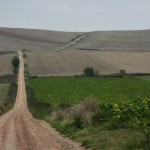 Via Francigena is regarded as a bundle of roads leading to the holy places of faith; in the Middle Ages pilgrims could stay in Rome by the tombs of Saints Peter and Paul or continue along the ancient Via Appia to the ports of Apulia, where was possible to embark and reach Jerusalem. To the north, cross the Alps, was connected to the Via Tolosana leading to Santiago de Compostela, where the relic of St. James the Apostle was a strong attraction for pilgrims from all over Europe.
Via Francigena is regarded as a bundle of roads leading to the holy places of faith; in the Middle Ages pilgrims could stay in Rome by the tombs of Saints Peter and Paul or continue along the ancient Via Appia to the ports of Apulia, where was possible to embark and reach Jerusalem. To the north, cross the Alps, was connected to the Via Tolosana leading to Santiago de Compostela, where the relic of St. James the Apostle was a strong attraction for pilgrims from all over Europe.

It was the channel for both cultural and commercial exchanges: the merchants traveled to reach the premises of major exhibitions such as those of Champagne and Flanders where they were also much sought after precious silks from Lucca. Even the Crusaders of the XI century followed this route for the reconquest of the Holy Sepulchre of Christ, along with kings, popes and princes.
One of the most famous journeys through the Via Francigena is the one made by the Archbishop of Canterbury Sigerico the Serious (who lived from 950 to 994) who returned from Rome to his native Canterbury after receiving, by the Pope himself, the pallium (a sacred vestment made by a strip of white cloth to be placed on the shoulders). From the records of Sigerico is outlined the route of the Via Francigena, in its 79 stages, also considering Acquapendente IX, who later became the Acquapendente city; site in the far north of Lazio, bordering Tuscany, is a town full of attractions and boasts the historic festival of Pugnaloni that every year records an increasingly high number of visitors.
 In the XII century was the icelandic abbot Nikulás from Munkaþverá to make the same journey; the abbot, a Benedictine monk, in 1154 returned to Iceland from a pilgrimage to the Holy Land and carefully described his journey in Leiðarvísir (Itinerarium). His journey begins from Iceland, through a stretch of sea from Norway to the shores of Denmark, West Germany and then passed, along the upper reaches of the Rhine, through Switzerland and Italy. The Italian side of the trip does not differ appreciably from that of Sigerico in the Tuscany to Rome, but then continues on Appia Traiana for embarking from the ports of Apulia. After Italy, in fact, starts a new route by sea, touching several points of the coasts and islands of Greece and the Balkan Peninsula, leading to Asia Minor up to Turkey and then to Jerusalem.
In the XII century was the icelandic abbot Nikulás from Munkaþverá to make the same journey; the abbot, a Benedictine monk, in 1154 returned to Iceland from a pilgrimage to the Holy Land and carefully described his journey in Leiðarvísir (Itinerarium). His journey begins from Iceland, through a stretch of sea from Norway to the shores of Denmark, West Germany and then passed, along the upper reaches of the Rhine, through Switzerland and Italy. The Italian side of the trip does not differ appreciably from that of Sigerico in the Tuscany to Rome, but then continues on Appia Traiana for embarking from the ports of Apulia. After Italy, in fact, starts a new route by sea, touching several points of the coasts and islands of Greece and the Balkan Peninsula, leading to Asia Minor up to Turkey and then to Jerusalem.
At today, there are many events related to the Via Francigena: festivals, culinary events, historical reenactments, visits to historic sites (including Museo del Fiore, the Cattedrale del Santo Sepolcro and Palazzo Viscontini in Acquapendente) and conferences.



 Scaricate la
Scaricate la 